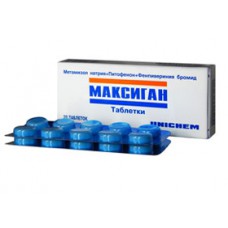Expiration date: 12/2026
The composition and form of issue:
Tablets, 1 tablet contains:
Metamizole sodium 500 mg
pitofenone hydrochloride 5 mg
fenpiverinia bromide 0, 1 mg
excipients: lactose, starch, silicon dioxide talc magnesium stearate
blistere in 10 PCs. in cardboard pack 1, 2 or 10 blisters.
Solution for injection, 1 ml contains:
Metamizole sodium 500 mg
pitofenone hydrochloride 2 mg
fenpiverinia bromide 0, 02 mg
auxiliary substances: hydrochloric acid water for injections
the dark neutral glass vials of 5 ml, in a contour acheikova package 5 ampoules, in a cardboard pack 1 pack or contour in plastic wrap (pallet) 5 ampoules in a pack a cardboard 1 pallet.
Description pharmaceutical form:
Tablets: white, round, flat, non-coated, chamfered and valium.
Solution for injection: clear, light yellow color.
Feature:
A combination drug.
Pharmacological action:
In the preparation includes: non-narcotic analgesic metamizol sodium (analgin), myotropic antispasmodic of pitofenone hydrochloride and m-anticholinergic remedy fenpiverinia bromide.
Metamizole is a pyrazolone derivative having analgesic, antipyretic and anti-inflammatory effect. Pitofenone hydrochloride, similar to papaverine, has a direct myotropic effect on smooth muscles of internal organs and causes its relaxation. Fenpiverinia bromide through m-holinoblokirutego action has an additional relaxing effect on smooth muscles.
The combination of the three components of the drug leads to pain relief, relaxation of smooth muscle, reduce elevated body temperature.
Indications:
Weak or moderate pain syndrome spasm of smooth muscles of internal organs: kidney, liver, biliary and intestinal colic, biliary dyskinesia, algomenorrhea.
For short-term symptomatic treatment: arthralgia, neuralgia, myalgia, sciatica.
As a subsidiary of LS: pain syndrome after surgical interventions and diagnostic procedures.
If necessary, the drug can be used to reduce elevated body temperature in cold and infectious and inflammatory diseases (tablets).
Contraindications:
Hypersensitivity to the pyrazolone derivative (phenylbutazone, tribuson), other components of the drug, inhibition of bone marrow hematopoiesis, stable and unstable angina, chronic heart failure decompensation, severe liver or kidney disease, the deficit glukozo-6-fosfatdegidrogenaza, tachyarrhythmia, acute "intermittent" porphyria, form-closure glaucoma, prostatic hyperplasia (with clinical manifestations), intestinal obstruction, megacolon, collapse, granulocytopenia, pregnancy (especially I trimester and last 6 weeks), the period of breast-feeding, child age (up to 5 years — tablets, up to 3 months or with weight <5 kg solution for injection).
With caution and under the supervision of a physician — patients with compromised function of liver or kidneys, with inclination to arterial hypotension (SBP <100 mm Hg. degree), bronchospasm, bronchial asthma, increased individual sensitivity to NSAIDs or narcotic analgesics (including "aspirin" triad history).
Children and adolescents under 18 years of age the drug should be used only as directed by your doctor.
Application of pregnancy and breast-feeding:
Contraindicated in pregnancy (especially in I trimester and last 6 weeks). At the time of treatment should stop breastfeeding.
Side effects:
In therapeutic doses the drug is generally well tolerated. Sometimes allergic reactions (skin rash, itching, angioedema, rarely, anaphylactic shock, urticaria), angioedema. In a few cases — a burning sensation in the epigastric region, dry mouth, headache. Possible dizziness, reducing AD, tachycardia, cyanosis. With prolonged use — violation of hematopoiesis: thrombocytopenia, leukopenia, agranulocytosis (may manifest the following symptoms: unmotivated rise in body temperature, chills, sore throat, difficulty swallowing, stomatitis, as well as the development of the phenomena of vaginitis or proctitis). The tendency to bronchospasm may provoke attack. In very rare cases — malignant exudative erythema (Stevens-Johnson syndrome), toxic epidermal necrolysis (Lyell's syndrome). Rarely (usually with prolonged use or high doses) — impaired renal function: oliguria, anuria, proteinuria, interstitial nephritis, urine staining in red. Rarely — decreased sweating, paresis of accommodation, difficulty urinating.
Local reactions: when the/m introduction of a possible infiltration at the injection site.
Drug interactions:
The simultaneous use of Maxigan with other non-narcotic analgesics can lead to mutual reinforcement of toxic effects. Tricyclic antidepressants, contraceptives for admission inside, allopurinol violate metabolism of metamizol sodium in the liver and increase its toxicity. Barbiturates, phenylbutazone and other inducers of microsomal liver enzymes weaken the effect of metamizol sodium. Concurrent use with cyclosporine reduces the level of the latter in the blood. Sedatives and tranquilizers increase the analgesic effect of metamizol sodium. The joint appointment with the H1-histamine antagonists, butyrophenone, phenothiazine, amantadine and quinidine may increase m-anticholinergic action. When used together with ethanol — mutual enhancement effects. Simultaneous application with chlorpromazine or other phenothiazine derivatives can lead to the development of severe hyperthermia. Radiopaque drugs, colloidal blood substitutes should not be used during treatment with drugs containing metamizol sodium. Metamizole, displacing connection with protein oral hypoglycemic drugs, indirect anticoagulants, corticosteroids and indomethacin, may increase the severity of their actions. Tiamazol and cytostatics increase the risk of leukopenia. The effect of increasing the codeine, H2-histamine antagonists and propranolol (slow inactivation metamizol sodium).
Solution for injection farmatsevticeski incompatible with other drugs.
If necessary, the simultaneous application of these and other drugs should consult a doctor.
Method of application and dose:
Tablets: inside (better after eating), adults and children over 15 years usually on the table 1-2. 2-3 times a day. Daily dose should not exceed 6 table. Duration of reception no more than 5 days. The increase in the daily dose or duration of treatment is possible only on the recommendation and under the supervision of a physician.
In children the drug is used only on prescription.
Children 6-8 years of age — 1/2 tab., 9-12 years — 3/4 table. 13-15 years — 1 table. 2-3 times a day.
Solution for injection: parenteral (in/in, in/m). Adults and adolescents over 15 years with acute severe colic give/in slowly in 2 ml (1 ml for 1 min), if necessary, repeated after 6-8 hours For the slow in/in the introduction is usually sufficient 2 ml of the drug. In/m administered 2 ml 2 times a day, the daily dose should not exceed 4 ml. Duration of treatment — no more than 5 days.
The/m or/in, Maxigan prescribed to children, depending on age and body weight following single doses (see table.):
Table
| Body weight/age | Solution for injection, in/in the introduction, ml | Solution for injection, in/m introduction, ml |
| Infants 5-8 kg 3-11 months | In/in the introduction is contraindicated | 0, 1–0, 2 |
| Children 9-15 kg 1-2 years | 0, 1–0, 2 | 0, 2–0, 3 |
| Children 16-23 kg 3-4 years | 0, 2–0, 3 | 0, 3–0, 4 |
| Children 24-30 kg 5-7 years | 0, 3–0, 4 | 0, 4–0, 5 |
| Children 31 to 45 kg 8-12 years | 0, 5–0, 6 | 0, 6–0, 7 |
| Children 46 to 53 kg 12-15 years | 0, 8–1, 0 | 0, 8–1, 0 |
If necessary, may be repeated administration of the drug in the same doses.
The solution is not compatible in the same syringe with other drugs.
Before the introduction of injectable solution should be warm in his hand.
Overdose:
Symptoms: vomiting, dryness in mouth, change in sweating, disturbance of accommodation, decreased blood pressure, drowsiness, confusion, nausea, epigastric pain, impaired liver and kidneys, cramps.
Treatment: gastric lavage, the appointment activated carbon, symptomatic therapy.
Special instructions:
Prolonged (more than 1 week) use of the drug requires monitoring of peripheral blood (leucocytes) and the functional state of the liver. If you suspect a agranulocytosis, or in the presence of thrombocytopenia should stop taking the drug. During the period of drug treatment should not take alcohol. It is not recommended to drive vehicles and doing other potentially hazardous activities that require quick physical and mental reactions.
The solution for injection should not be used for relief of acute abdominal pain to determine the cause. Parenteral administration is typically used in cases of emergency (renal or biliary colic) and in cases when oral intake is impossible or impaired absorption from the gastrointestinal tract. Particular care is required with the introduction of 2 ml or more (risk of sharp decline AD). In/in the injection should be performed slowly, in the lying position and under the control of AD curves and frequency of breathing.



